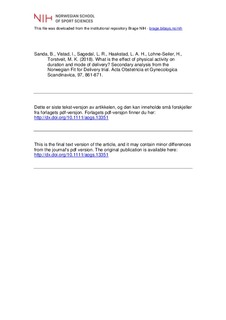| dc.contributor.author | Sanda, Birgitte | |
| dc.contributor.author | Vistad, Ingvild | |
| dc.contributor.author | Sagedal, Linda Reme | |
| dc.contributor.author | Haakstad, Lene Annette Hagen | |
| dc.contributor.author | Lohne-Seiler, Hilde | |
| dc.contributor.author | Torstveit, Monica Klungland | |
| dc.date.accessioned | 2019-05-21T11:07:01Z | |
| dc.date.available | 2019-05-21T11:07:01Z | |
| dc.date.created | 2018-07-30T16:57:41Z | |
| dc.date.issued | 2018 | |
| dc.identifier.citation | Acta Obstetricia et Gynecologica Scandinavica. 2018, 97 (7), 861-871. | nb_NO |
| dc.identifier.issn | 0001-6349 | |
| dc.identifier.uri | http://hdl.handle.net/11250/2598258 | |
| dc.description.abstract | Introduction: The beneficial effects of physical activity during pregnancy for the mother and offspring have been reported by several studies but there are conflicting results concerning the possible effect of physical activity on the course of labor and risk of cesarean delivery. This study presents secondary analyses from the Norwegian Fit for Delivery randomized controlled trial, aiming at studying the effect of a lifestyle intervention including group exercise classes, as well as the possible influence of physical activity level in late pregnancy, on labor outcomes. Material and methods: Healthy nulliparous women with singleton pregnancy were randomized to an intervention group, n = 303 (dietary counseling and twice‐weekly exercise classes) or a control group, n = 303 (standard care). The participants were analyzed both by randomization and as a cohort comparing women with lowest (quartile 1, 0 metabolic equivalent of task‐hours moderate‐to‐vigorous physical activity/week) (n = 140) vs. highest (quartile 4, ≥16 metabolic equivalent of task‐hours moderate‐to‐vigorous physical activity/week) (n = 131) physical activity level in late pregnancy, assessed with the International Physical Activity Questionnaire. Result: The intervention group had a longer first stage of labor compared with the control group (293 ± 202 min vs. 257 ± 181 min, p = 0.030). No differences between the randomization groups were seen for time spent in second stage of labor, prolonged labor or mode of delivery. In the total sample, women with the highest physical activity level had lower odds ratio (OR) of acute cesarean delivery (OR 0.33, 95% CI 0.11–0.97, p = 0.044) than did those with the lowest physical activity‐level. Conclusion: A significantly longer first stage of labor was observed in the intervention group than in the control group. A high physical activity level in late pregnancy was associated with lower odds of acute cesarean delivery compared with a low physical activity level. | nb_NO |
| dc.description.abstract | What is the effect of physical activity on duration and mode of delivery? Secondary analysis from the Norwegian Fit for Delivery trial | nb_NO |
| dc.language.iso | eng | nb_NO |
| dc.title | What is the effect of physical activity on duration and mode of delivery? Secondary analysis from the Norwegian Fit for Delivery trial | nb_NO |
| dc.type | Journal article | nb_NO |
| dc.type | Peer reviewed | nb_NO |
| dc.description.version | acceptedVersion | nb_NO |
| dc.source.pagenumber | 861-871 | nb_NO |
| dc.source.volume | 97 | nb_NO |
| dc.source.journal | Acta Obstetricia et Gynecologica Scandinavica | nb_NO |
| dc.source.issue | 7 | nb_NO |
| dc.identifier.doi | 10.1111/aogs.13351 | |
| dc.identifier.cristin | 1599051 | |
| dc.description.localcode | Nivå1 | nb_NO |
| cristin.unitcode | 201,18,2,0 | |
| cristin.unitname | Institutt for folkehelse, idrett og ernæring | |
| cristin.ispublished | true | |
| cristin.fulltext | postprint | |
| cristin.qualitycode | 1 | |
